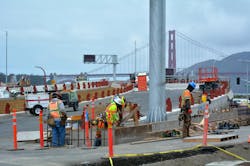Barricades and Bravery
By Daniel Venezuela, Contributing Author
In the bustling world of highway construction, traffic management workers play a crucial role in ensuring the safety and efficiency of our roads. These unsung heroes work around the clock, often under challenging conditions, to keep things flowing smoothly.
Let's take an hour-by-hour journey through a typical day, witnessing firsthand the meticulous processes and dedicated efforts that go into preparing and maintaining a highway work zone.
6 a.m. – Morning Briefing
Our day at traffic management headquarters begins at dawn, where the team gathers for the Pre-Job Safety Briefing. Here, the crew reviews the day's tasks, discusses potential safety concerns, and goes over the layout of the work zone.
Coordination and communication are key. Everyone must be on the same page before heading out to the site. And they must be wearing the appropriate gear, which often includes hard hats, safety toe boots and high-visibility vests.
Additionally, every team member is equipped with a storm whistle—a vital tool in noisy work areas for promptly signaling danger to others.
7 a.m. – Site Arrival and Setup
The first order of business is setting up the necessary traffic control devices in accordance with the approved traffic control plan, including cones, barrels and signage. Precision and attention to detail are crucial during this phase to prevent confusion.
With the work zone established, our focus shifts to monitoring traffic flow. Using a combination of visual observation and technology such as traffic cameras, we assess the effectiveness of the setup and make any adjustments as needed.
9 a.m. – Coordination with Crews
As construction activity picks up, we work closely with the crews to coordinate movements within the zone.
This includes scheduling lane closures, equipment movements, and ensuring that all workers are aware of the traffic patterns around them. Effective communication prevents accidents and ensures that work progresses efficiently.
10 a.m. – Safety and Job Inspection
Mid-morning, we conduct a thorough safety and job inspection of the work zone. This includes checking the placement and condition of traffic control devices, ensuring clear visibility for drivers, and verifying that all protocols are being followed.
Noon – Lunch and Team Check-In
Even in the fast-paced environment of a work zone, taking a break is essential. During lunch, the team takes a moment to regroup, discusses the morning's progress and plans for the afternoon. It’s also a good time to make sure we’re staying well hydrated, which avoids heat stress and improves attentiveness.
3 p.m. – Incident Response
Despite the best planning, accidents can occur within the work zone. When a minor traffic incident happens, we’re on the front line, coordinating with emergency services and even providing first aid if necessary.
In our line of work, the unexpected is an everyday occurrence. It is the quick implementation of contingency plans that keeps traffic moving and maintains safety.
5 p.m. – Evening Traffic Management
As the workday winds down for many, traffic volume increases. We remain vigilant, managing the surge of rush hour commuters.
This might involve adjusting lane closures or traffic control setups to accommodate the higher congestion.
6 p.m. – Work Zone Adjustment
Before concluding our day, we conduct a final check of the work zone to make sure everything is prepared for the night shift.
This includes a handover meeting where we share insights from the day's activities and any specific adjustments for overnight operations, such as enhanced lighting, ensuring reflective materials are in place, as well as possibly reconfiguring the setup.
6:30 p.m. – Documentation and Reporting
Finally, we shift our focus to documentation and reporting using apps from the field.
This represents a notable advancement in the ongoing digital transformation of traffic management. Rather than heading back to the office, we employ these tools directly on-site to log the day's activities, incidents, and any alterations to the work zone.
This methodology is essential for upholding regulatory standards, streamlining future planning efforts, and continually refining best practices.
7 p.m. - Reflection and Rest
Now, it's time to rejuvenate, reflect and prepare for tomorrow. Maintaining a healthy diet and ensuring a restful night's sleep are vital for staying alert and energized.
Traffic management experts are dedicated individuals who navigate through a meticulously orchestrated day. Their work is never truly finished, but it's this enduring dedication that drives the ongoing evolution of traffic management practices.
Keeping our roads safe and efficient for everyone makes it all worthwhile. RB
Daniel Venezuela is general manager for AWP Safety’s Texas region. AWP Safety plans and coordinates work zone projects requiring the use of sophisticated traffic control devices.
